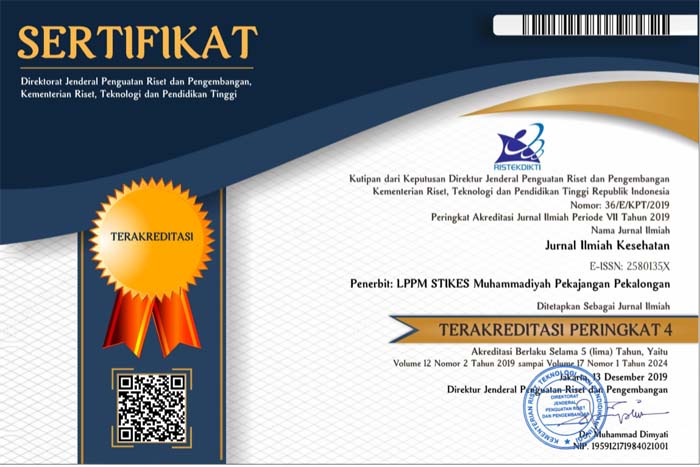The Characteristics of female students in Allied Health Sciences Institution who performed routine breast self-examination (BSE) in Indonesia and Pakistan
DOI:
https://doi.org/10.48144/jiks.v16i1.1412Keywords:
attitude, allied health sciences, breast cancer awareness, breast self-examination, studentsAbstract
Breast cancer is a major public health concern worldwide. The incidence of breast cancer remains high. The mortality rate and prognosis for breast cancer can be improved with early diagnosis and therapy. Self-examination of the breasts is a common method of early diagnosis for women's health issues. This study aimed to explore the characteristics of female students in Allied Health Sciences Institution who performed regular breast self-examination in Indonesia and Pakistan. After institutional ethics review board approval and informed consent, a quantitative survey recruited 430 female students from Allied Health Sciences institutions in Indonesia and Pakistan. This study strictly followed the highest level of ethical standards proposed by Helsinki Declaration (Revised 2013). A closed and open-ended questionnaire was used to collect data on their demographics and characteristics. The questionnaire was distributed online using a google form. Data were analyzed using descriptive analytics . The findings of this study showed that n=395(91.86%) were aged 18-35 years, and 51% were from rural. 49% from urban areas. The majority of participants were single or never married (88%). Most participants were undergraduate students (95.35%). Almost half participants did routine BSE once a month (48.6%). Only 16% were very confident about doing a breast self-examination. Nearly half respondents had never seen a doctor (47%). A positive attitude was seen among all the students. Additionally, most students performed a weekly breast examination. Evidently, more than half of the participants lacked self-assurance when it came to performing a breast assessment. We found a significant percentage who had never been to a doctor for medical attention. Public campaigns to raise awareness and urge female student in allied health science to regularly see their doctors and engage in BSE are so crucial
References
World Health Organzation. 2021. Breast Cancer. https://www.who.int/news-room/fact-sheets/detail/breast-cancer , Accessed Feb 3, 2023
Konieczny, M., Cipora, E., Sygit, K., Fal, A. 2020. Quality of Life of Women with Breast Cancer and Socio-Demographic Factors. Asian Pacific Journal of Cancer Prevention, Vol 21. DOI:10.31557/APJCP.2020.21.1.185
Sun, Y. S., Zhao, Z., Yang, Z. N., Xu, F., Lu, H. J., Zhu, Z. Y., Shi, W., Jiang, J., Yao, P. P., & Zhu, H. P. (2017). Risk Factors and Preventions of Breast Cancer. International journal of biological sciences, 13(11), 1387–1397. https://doi.org/10.7150/ijbs.21635
Kashyap, D., Pal, D., Sharma, R., Garg, V. K., Goel, N., Koundal, D., Zaguia, A., Koundal, S., & Belay, A. (2022). Global Increase in Breast Cancer Incidence: Risk Factors and Preventive Measures. BioMed research international, 2022, 9605439. https://doi.org/10.1155/2022/9605439
Nelson, H. D., Fu, R., Cantor, A., Pappas, M., Daeges, M., & Humphrey, L. (2016). Effectiveness of Breast Cancer Screening: Systematic Review and Meta-analysis to Update the 2009 U.S. Preventive Services Task Force Recommendation. Annals of internal medicine, 164(4), 244–255. https://doi.org/10.7326/M15-0969
Coleman C. (2017). Early Detection and Screening for Breast Cancer. Seminars in oncology nursing, 33(2), 141–155. https://doi.org/10.1016/j.soncn.2017.02.009
Hassan, L. M., Mahmoud, N., Miller, A. B., Iraj, H., Mohsen, M., Majid, J., Reza, S. M., & Mojgan, M. (2015). Evaluation of effect of self-examination and physical examination on breast cancer. Breast (Edinburgh, Scotland), 24(4), 487–490. https://doi.org/10.1016/j.breast.2015.04.011 [8] Solikhah, S., Promthet, S., & Hurst, C. (2019). Awareness Level about Breast Cancer Risk Factors, Barriers, Attitude and Breast Cancer Screening among Indonesian Women. Asian Pacific journal of cancer prevention : APJCP, 20(3), 877–884. https://doi.org/10.31557/APJCP.2019.20.3.877
Osei-Afriyie, S., Addae, A. K., Oppong, S., Amu, H., Ampofo, E., & Osei, E. (2021). Breast cancer awareness, risk factors and screening practices among future health professionals in Ghana: A cross-sectional study. PloS one, 16(6), e0253373. https://doi.org/10.1371/journal.pone.0253373
CDC. 2019. United States Cancer Statistics: Data Visualizations. https://gis.cdc.gov/Cancer/USCS/#/Demographics/, Accessed Feb 3, 2023
American Cancer Society. Key Statistics for Breast Cancer. https://www.cancer.org/cancer/breast-cancer/about/how-common-is-breast-cancer.html. Accessed Feb 3, 2023
Dong, J. Y., & Qin, L. Q. (2020). Education level and breast cancer incidence: a meta-analysis of cohort studies. Menopause (New York, N.Y.), 27(1), 113–118. https://doi.org/10.1097/GME.0000000000001425
LeBlanc, G., Lee, I., Carretta, H., Luo, Y., Sinha, D., & Rust, G. (2022). Rural-Urban Differences in Breast Cancer Stage at Diagnosis. Women's health reports (New Rochelle, N.Y.), 3(1), 207–214. https://doi.org/10.1089/whr.2021.0082
Nagrani, R., Mhatre, S., Boffetta, P., Rajaraman, P., Badwe, R., Gupta, S., Romieu, I., Parmar, V., & Dikshit, R. (2016). Understanding rural-urban differences in risk factors for breast cancer in an Indian population. Cancer causes & control : CCC, 27(2), 199–208. https://doi.org/10.1007/s10552-015-0697-y
Li, M., Han, M., Chen, Z., Tang, Y., Ma, J., Zhang, Z., Liu, Z., Zhang, N., Xi, C., Liu, J., Tian, D., Wang, X., Huang, X., Chen, J., Wang, W., & Zhai, S. (2020). Does marital status correlate with the female breast cancer risk? A systematic review and meta-analysis of observational studies. PloS one, 15(3), e0229899. https://doi.org/10.1371/journal.pone.0229899
Hinyard, L., Wirth, L. S., Clancy, J. M., & Schwartz, T. (2017). The effect of marital status on breast cancer-related outcomes in women under 65: A SEER database analysis. Breast (Edinburgh, Scotland), 32, 13–17. https://doi.org/10.1016/j.breast.2016.12.008
Martínez, M. E., Unkart, J. T., Tao, L., Kroenke, C. H., Schwab, R., Komenaka, I., & Gomez, S. L. (2017). Prognostic significance of marital status in breast cancer survival: A population-based study. PloS one, 12(5), e0175515. https://doi.org/10.1371/journal.pone.0175515
Micah M. Pippin; Roxanne Boyd. 2022. Breast Self Examination. https://www.ncbi.nlm.nih.gov/books/NBK565846/
Coleman C. Early Detection and Screening for Breast Cancer. Semin Oncol Nurs. 2017 May;33(2):141-155
National Breast Cancer, Inc. How often should I do a breast self exam (BSE)? https://www.nationalbreastcancer.org/breast-cancer-faqs/how-often-should-i-do-a-breast-self-exam-bse/. Accessed February 4, 2023
Margaret Fry, Casimir MacGregor, 2014. Confidence and impact on clinical decision-making and behaviour in the emergency department, Australasian Emergency Nursing Journal, Volume 17, Issue 3, P 91-97, https://doi.org/10.1016/j.aenj.2014.03.003.
Haavardsholm, I., & Nåden, D. (2009). The concept of confidence - the nurse's perception. European journal of cancer care, 18(5), 483–491. https://doi.org/10.1111/j.1365-2354.2008.00993.x
American Cancer Society. American Cancer Society Recommendations for the Early Detection of Breast Cancer. https://www.cancer.org/cancer/breast-cancer/screening-tests-and-early-detection/american-cancer-society-recommendations-for-the-early-detection-of-breast-cancer.html . Accessed Feb 4, 2023












